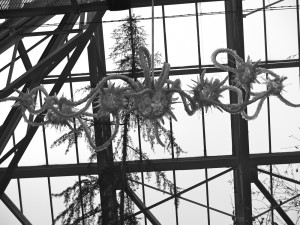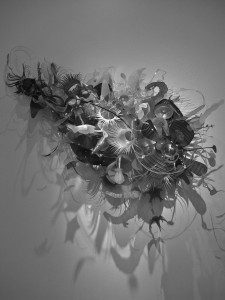
Transcript Reporter
The saying goes, “one man’s trash is another man’s treasure,” and the work of artist Aurora Robson is no exception.
Robson uses plastic taken from the waste stream and junk mail as her mediums for her artwork.
Last Wednesday, Robson spoke at Ohio Wesleyan about her work; her latest collaborative project, Project Vortex; and her exhibit in Columbus.
The lecture was sponsored by The Arts Castle, the Ross Art Museum and the Ohio Wesleyan Sustainability Task Force with funds from PNC Arts Alive.
According to Justin Kronewetter, director of the Ross Art Museum, Wednesday wasn’t the first time Robson’s work has been recognized on campus.
“In 2008, we had several of her works on display as part of an exhibit called ‘Discarded to Distinctive,’” Kronewetter said. “And that exhibition featured work that had been created literally out of discarded objects.”

“Most skilled people who help me in my studio or myself could clean about 100 bottles a day,” Robson said.
“And we need to get them perfect so that there’s absolutely no grime or germs or residue, like you’re ready to sculpt with.”
Throughout Robson’s career she estimates having used over 75,000 plastic bottles and 100,000 bottle caps.
“I also like to use excess packaging in addition to plastic debris,” Robson said. “I guess I like to take anything that is on a downward, negative trajectory and try to as practice, as a person, as an artist, and to be honest sometimes I fail miserably – but try to see if I can redirect it with art.”
Robson’s pieces vary in shape, size and color. Some have a tranquil, elegant appeal, while others have a darker message.
“What I was thinking about with these dark pieces was this issue of our relationship to matter and our relationship to what we call waste,” Robson said.
“When we throw something away there really is no ‘away.’ Every single ‘away’ is somebody’s home. They might be microscopic and seem insignificant, but this is the only planet teeming up with life that we’ve discovered this far.”
One of Robson’s first dark pieces is “Belch,” which was completed in 2009 and is made with approximately 6,000 plastic bottles.
“I was trying to draw people’s attention to the issue of plastic debris getting into our oceans and water and the idea of Belch is that it’s something you try to throw away, you try to bury it and it comes up,” she said.
Robson’s latest project, Project Vortex, was founded in 2009 as a collaboration among a group of international artists, designers and architects who are interested in intercepting the waste stream through their work. Robson is its founder.
The project is in collaboration with a water cleanup organization that collects plastic debris from rivers, lakes and ocean shores.
The collected will be used in Project Vortex, and all of its proceeds will be donated to the cleanup organization.
Robson’s work has also had a local impact in Delaware. The Arts Castle is in the process of putting together a series of events centered around the same goals as Robson’s.
“We have lots planned for upcoming months centered around recycling and reducing waste,” said Diane Hodges, executive director at the Arts Castle. “We will have lectures, workshops, exhibits (and) productions. We have a show lined up called ‘Greenerella,’ which is a play off of Cinderella, but has to do with going green.”
Robson’s work will be on display at the Franklin Park Conservatory until April 28.
The Conservatory also hosts “Cocktails at the Conservatory,” at which Robson’s piece featuring solar-powered LED lights will be lit up for observers.